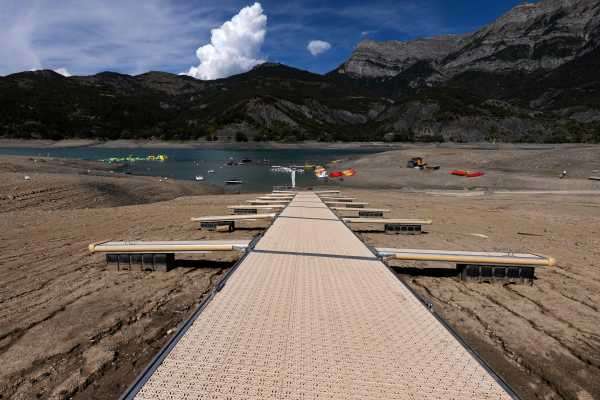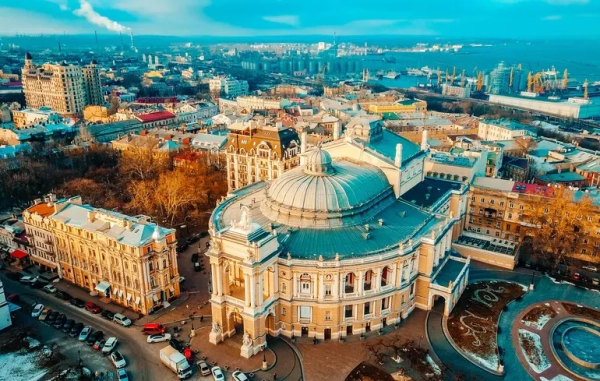
The summer of 2022 has seen significant, sustained drought across the globe, from Europe to China, to the US and Africa, and has brought with it serious ripple effects, from energy shortages to severe food insecurity.
Places like California in the US have suffered from droughts for years, with statewide restrictions on water use becoming the norm. But record droughts in other areas of the world like Europe and Asia are affecting everything from agriculture to energy transport. Many places now suffering from severe heat and drought — like the UK — don’t necessarily have the infrastructure to deal with such weather extremes. And when rain does eventually fall, it’s likely to cause flooding due to sustained heat and dryness, as well as the sheer amount of built-up precipitation released at once.
This summer’s widespread drought doesn’t paint a particularly hopeful picture for our collective climate future, and though some places like China are turning to creative approaches like cloud seeding to at least protect agriculture, heat waves are likely to get more severe in the future — contributing to further drought. That means more wildfires, more challenges for agriculture, particularly in poor countries, and more displacement and famine.
Droughts are everywhere, and they have a variety of causes
Droughts aren’t unprecedented events; they’ve happened throughout history and have contributed to devastating effects like famine and displacement. In the US, the most severe drought incident on record is the Dust Bowl of the 1930s, in which low rainfall, extreme heat, and severe financial distress caused by the Great Depression, among other factors, intersected to cause crop failure, poverty, and displacement in parts of Kansas, Colorado, New Mexico, Texas, and Oklahoma.
The droughts now plaguing parts of North America, the Horn of Africa, China, Britain, and wider Europe don’t necessarily have just one cause. In many cases, droughts are a combination of particularly low rainfall and high temperatures. When temperatures rise, water evaporates more quickly, and when it does fall, it’s more likely to fall as rain instead of snow due to those same high temperatures, as Vox’s Neel Dhanesha explained. In California and the American West, snowpack — layers of snowfall kept frozen due to temperatures below freezing, which then melt as temperatures rise — is a significant source of water. Less snowpack due to higher temperatures, then, means that water sourcing is less reliable, and probably will continue to be in the coming decades — contributing to drought.
As Vox’s Benji Jones wrote, agriculture in parts of California and Arizona is suffering due to drought in the Colorado River and low water levels in two reservoirs, Lake Powell and Lake Mead. Farmers are the primary users of water from the Colorado River, and while some have already cut their supply, the drought isn’t likely to subside any time soon — meaning that future cuts will be necessary. That will be a problem for many Americans already reeling from high food prices due to inflation, Jones wrote:
In the Horn of Africa, low rainfall for four successive rainy seasons has caused the region’s worst drought in 40 years. In the region, which comprises Ethiopia, Kenya, and Somalia, occasional droughts were to be expected, and something communities could prepare for; in 2022, the twice-yearly rainy seasons have failed to materialize yet again, pushing millions toward famine. In 2020 and 2021, the spring rain season which is called the gu and typically lasts from March to May, came up short. In 2021 the deyr, which lasts from October through December, failed as well, according to NASA’s Earth Observatory. “These back-to-back blows are hard for the farmers to take,” Ashutosh Limaye, a scientist at NASA’s Marshall Space Flight Center said in January. “The challenge is not just the soil moisture or the rainfall anomalies; it is the resilience of the population to drought.”
China’s droughts in Hubei and Chongqing have combined with heavy rainfall in other parts the west, the Washington Post reported. In Chongqing, temperatures have reached 113 degrees Fahrenheit; in the county of Xinwen in the Sichuan province, temperatures reached 110°F this past week. That extreme heat has turned parts of the Yangtze River — a vital waterway and the longest river in China — arid. The drought has caused extensive crop damage and limited access to drinking water in the Hubei province, according to the local emergency authorities, and electricity from the Three Gorges Dam — the world’s largest — has fallen about 40 percent from last year, Bloomberg reports.
Though coal powers electricity in many provinces, the heat and drought in China has caused energy rationing in Sichuan, with authorities forcing factories to shut down to conserve energy. The province is a critical hub for solar panel and semiconductor manufacturing, as CNN reports, but residential and commercial air conditioning use has spiked due to the heat wave, straining the electricity grid, and the drought has depleted hydroelectric power.
China is also turning to cloud seeding — charging clouds with silver iodide to form ice crystals, resulting in precipitation — to try and save crop yields, as the Associated Press reported. While several countries, including the United States, have cloud seeding research programs, the technology has been around since the 1940s, as Laura Kuhl writes for the Bulletin of the Atomic Scientists. However, according to Kuhl, this isn’t a permanent solution; for starters, it doesn’t address the underlying cause of climate change, nor does it promote other mitigation efforts. Furthermore, there may be as-yet-unknown impacts from cloud seeding, like toxic buildup from the silver iodide commonly used to create condensation, and experts don’t fully know its efficacy or how it will affect long-term hydrological patterns.
Europe, particularly Britain, is also suffering from record heat and drought. Temperatures in the UK reached 104°F last week and nearly 109°F in southwestern France, according to Axios. Wildfires have been ravaging parts of France, Spain, and Portugal; rivers in Italy and Germany are at levels so low they are exposing battleships and bombs sunk during World War II, Reuters reports.
Double heat waves have combined with record rainfall shortages to produce drought in some parts of England, as the New York Times reported last week. It’s the first official drought in Britain since 2018; while droughts are not unheard of in this part of the world, the combination of record temperatures and low rainfall also contributed to fires in July and August in London, which the London Fire Brigade was ill-equipped to combat due to staff and funding cuts, emergency services union officials told the Times.
Europe, already feeling the strain of energy cuts due to sanctions on Russian fuel exports, is facing further challenges due to the drought, the New York Times reports. In Germany, ships carrying coal can’t safely navigate the shallow rivers, and Norway’s hydropower output, which provides some 90 percent of the country’s energy supply, hasn’t been so low in more than two decades.
“We are not familiar with drought,” Sverre Eikeland, chief operating officer of the Norwegian energy company Agder Energi, told the Times. “We need water.”
What do these droughts say about our climate future — and what can we do?
Although extreme heat, droughts, and floods have historical antecedents and intersecting causes, weather patterns during the summer of 2022 have been exacerbated by the human behavior, primarily industrialization and fossil fuel use, that causes climate change.
According to the World Weather Attribution initiative, an international consortium of climate scientists who study the causes of extreme weather events, the temperatures seen in the UK this July — as high as 40.3 degrees Celsius, or nearly 105 degrees Fahrenheit, were “extremely unlikely” to have happened without human-made climate change. “While Europe experiences heatwaves increasingly frequently over the last years, the recently observed heat in the UK has been so extreme that it is also a rare event in today’s climate,” the study found. That study, which combined observational and modeling analyses, found that human-caused climate change made the excessive temperatures at least 10 times more likely.
“The first truth is that we live in a nightmare,” NASA climate scientist Kate Marvel told Axios regarding the extreme heat in Europe. “This is exactly what climate models projected was going to happen: intensifying extreme weather, severe public health consequences, and incredibly frustrating Congressional inaction. There is no reasonable scenario where the warming stops at 1.2°C, so it’s definitely going to get worse.”
Governments and aid organizations are trying to cope with drought and the resulting famine, energy cuts, wildfires, water shortages, and other crises with strategies like water and energy rationing and aid distribution, but the time has already passed for aggressive action to mitigate climate change. In fact, trends seem to be going in the opposite direction, with Europe once again turning to coal power due to sanctions on Russian fuel, as well as increased greenhouse gas emissions in the US last year, after years of stasis or decline, according to a report from the Rhodium Group.
There isn’t just one quick solution, like cloud seeding, to the problem of heat and drought; it took hundreds of years to reach the crisis level playing out in the world right now, and it will take significant, committed effort to produce any mitigating effects. Recent legislation passed in the US takes strides at making clean energy and electric vehicles more available to more people. It’s just a start, though — and if this summer’s droughts are any indication, there’s no time to waste in enacting more serious measures.
Will you support Vox’s explanatory journalism?
Millions turn to Vox to understand what’s happening in the news. Our mission has never been more vital than it is in this moment: to empower through understanding. Financial contributions from our readers are a critical part of supporting our resource-intensive work and help us keep our journalism free for all. Please consider making a contribution to Vox today.
Sourse: vox.com






